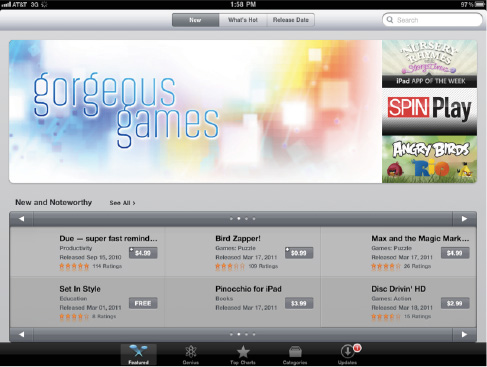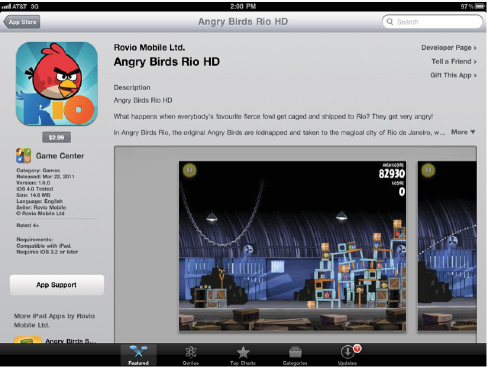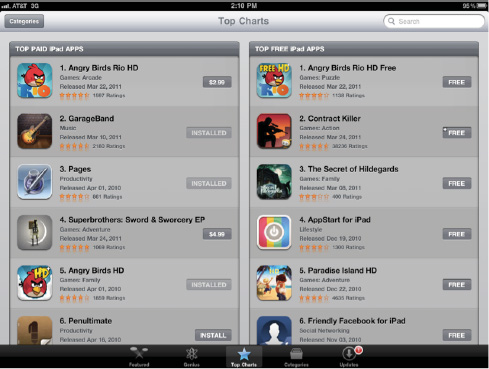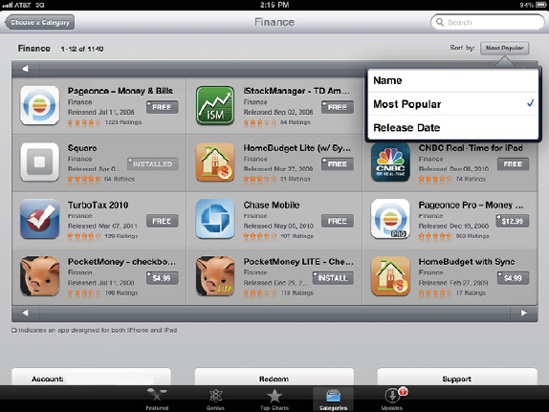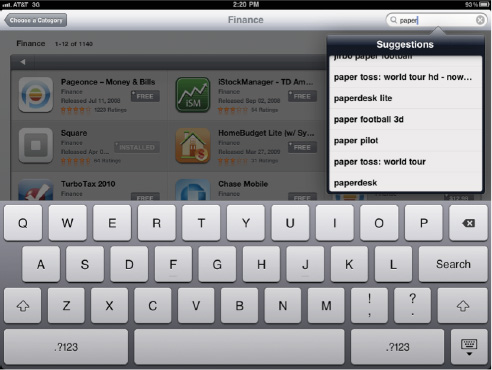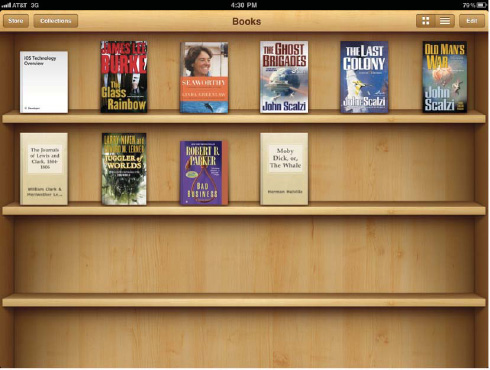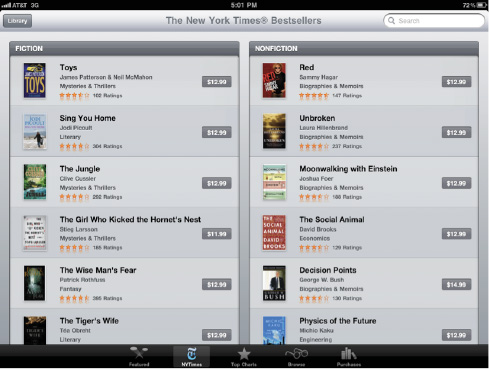You might think of your iPad as an Internet-connected computer, but it's much more than that. It's also a software store, a bookstore, a music store, and a place to buy videos and movies. Why drive to that Redbox kiosk to rent a movie or wait for a Netflix DVD to show up in the mail when you can rent a movie on your iPad and watch it immediately?
The iPad builds upon Apple's history of building electronic storefronts that make it easy to purchase digital content. This started with the iTunes Music Store on April 28, 2003, resulting in Apple becoming the number-one seller of music in the United States just five years later. Now known as the iTunes Store, Apple's digital store accounts for 70 percent of all worldwide digital music sales.
Through the iTunes Store, you have access to more than 11 million songs available worldwide. Your iPad, if it is using the U.S. iTunes Store, provides access to more than 1 million podcasts; 40,000 music videos; 3,000 TV shows; 20,000 audiobooks; 2,500 movies; and close to 300,000 iPhone and iPad apps.
You don't need to visit a physical store to buy those apps – they're all available from an application included with every iPad called the App Store. The App Store is analogous to a software-specific department in the overall iTunes Store, and the App Store app provides a quick way to search for, learn about, and purchase apps from your iPad.
Starting with the launch of the iPad on April 3, 2010, Apple opened the virtual doors of a new store, the iBookstore. Although it doesn't yet have the selection of Amazon's Kindle Bookstore, a large number of classic and new titles are available.
In this chapter, we'll take you on a virtual shopping spree buying apps, music, movies, videos and TV shows, and books, all while sitting with your iPad in front of you.
The App Store opened its virtual doors on July 11, 2008, and as of the printing of this book, more than 10 billion apps have been sold. Most of those apps were written for the iPhone and iPod touch but can run on an iPad unchanged. Many apps have been written especially to take advantage of the larger screen and faster processor of the iPad, and some apps run on both platforms but have improved capabilities that appear only when viewed on the iPad.
When you activated your iPad in Chapter 1, you were asked either to enter an existing Apple ID or to sign up for one. By doing this, Apple set up both the payment and authorization mechanism that is used by all of the on-device stores. That means you're ready to make purchases in any of the Apple stores directly from your iPad.
When you launch the App Store on your iPad, you're greeted with a screen that looks like Figure 8-1.
By default, the App Store initially shows you featured apps. How can you tell? There are five icons at the bottom of the App Store page: Featured, Genius, Top Charts, Categories, and Updates.
At the top of the store you'll see three buttons: New, What's Hot, and Release Date. Each one of these buttons displays a slightly different view of the inventory of the App Store. Start by looking at the New view.
At the top of the page is an ever-changing sample display of new apps. These apps have been highlighted by the App Store staff as being either unique or best-selling. When you see an app that you'd like more details about, just tap it, and a detailed app description appears (see Figure 8-2).
The app description screen displays a large version of the icon that appears on your iPad screen, as well as the price, the category that the app is in, information about the latest release, compatibility, and customer star ratings and reviews. Want to tell a friend about the app that you found? Tap the Tell a Friend link, and the App Store creates an e-mail that you can send to your buddy.
Note
If you have purchased an app and have problems with it, tap the Support button at the bottom of the Featured and Top Charts pages and you can let both Apple and the developer know about the issue. This button provides a link to Apple's support web pages concerning iTunes, and under the heading App Store and iBooks are links that display common troubleshooting tips and an "Email Us" button. Apple responds to most queries with 24 hours, which makes this the most direct way to get an answer. You can also tap the App Support button on the left side of an app description page (see Figure 8-2) to contact the developer directly.
The description of an app shows a maximum of about five lines of information on the iPad screen. To read more, tap the More link to expand the description (see Figure 8-3).
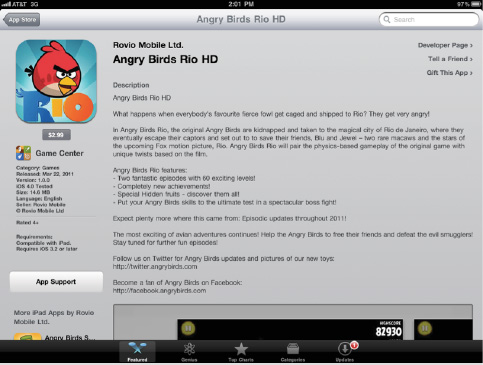
Figure 8.3. Tapping the More link expands the description of an app. Compare this description with the five-line description shown in Figure 8-2.
Buttons on the left side of the screen provide direct links to the developer's website and support page. The images displayed on the screen scroll, so to see all of them, just drag the visible picture to the left.
We recommend reading the customer ratings and reviews at the bottom of the app description page, although they can sometimes be misleading. We find that the reviews often point out common issues that other users may be having with the app, so you can decide whether to purchase the app now or wait for a revision. When you buy an app, you can also rate it and write a review for others to read. Ratings are applied by clicking anywhere from one (bad) to five (good) stars. If you choose to write a review instead, note that you'll be asked to sign into your iTunes account once more and that your review will be screened by Apple prior to publishing.
When you've decided to purchase an app, all you need to do is tap the price. The price turns to a green Install App button, which you then tap. A dialog box appears on your iPad screen asking you to enter your iTunes password and then tap OK. Once you've done that, the app is downloaded and installed onto your iPad. You'll receive an e-mail receipt from Apple outlining your purchase within a few days.
Note
When you tap OK and the download begins, the App Store closes, and the home screen of your iPad appears. Don't be alarmed; this is normal. This also happens when you're updating apps.
Let's go back to the App Store for a few minutes and talk about the other areas on the New screen. Below the spotlighted section is a New and Noteworthy section of apps (see Figure 8-4). Apple's staff chooses this crop of apps from new entries to the App Store, and the apps are often unique and fun. To scroll through the New and Noteworthy apps, tap the white arrows on the left and right sides.
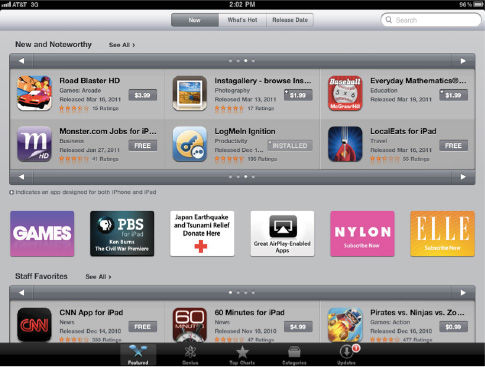
Figure 8.4. New and Noteworthy apps are singled out for extra attention in the App Store for interesting functionality, fun game play, or tremendous value.
Next on the screen is usually a small group of icons, pointing to an App of the Week, groups of similar apps (apps for kids or music creation apps, for example), or apps that deserve special attention.
Continuing down the App Store screen, there's a selection of Staff Favorites (see Figure 8-5). These may not necessarily be new apps, but they've captured the hearts of the App Store staff, and they'd like for you to know about them. As with the New and Noteworthy apps, you can browse through the selection by tapping the white left and right arrows.
At the bottom of the App Store is a set of Quick Links. If your account currently has an unspent balance, that amount is listed. By tapping that balance, you can view or change any of your iTunes account information. If you don't have a balance, that information is available by tapping the Account button at the very bottom of the App Store screen.
See that Redeem button in Figure 8-6? That's a fun way to buy apps on someone else's dime. You may be lucky enough to get a "promo code" from a developer. That's a code that can be redeemed for a free copy of an app. When you tap Redeem, a dialog box appears into which you can enter that code, an iTunes Gift Card code, or a gift certificate code number. Enter the code and tap Redeem, and then enter your iTunes password. If you've entered a promo code for a specific app, that app is downloaded and installed. If you've entered a gift card or certificate code, then your iTunes account is credited for the value of the card or certificate.
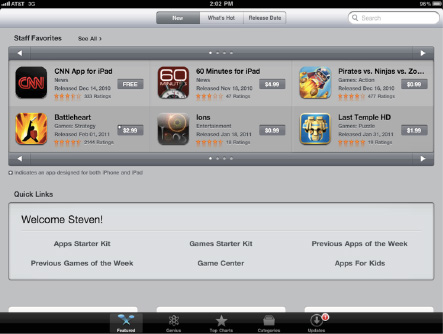
Figure 8.5. Staff Favorites, Quick Links, and the common App Store buttons are found at the bottom of the App Store screen.
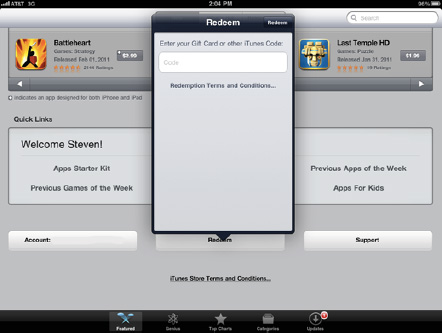
Figure 8.6. Redeeming promo codes, gift cards, and gift certificates is a nice way to buy many apps.
The last button on the bottom of the App Store screen is for Support. Tapping this button directs you to the iTunes support web page (www.apple.com/support/itunes) in the Safari web browser.
The answers to many common questions are found on the iTunes support page, so be sure to browse through the information before requesting further help. If you don't see an answer for your questions about iTunes, the App Store, the iBookstore, or purchases of music or videos, there's a button for sending an e-mail to the iTunes Store support team. In most cases, you'll receive a response within 24 hours.
The What's Hot screen displays a similar layout to New, except with a listing of What's Hot apps in place of New and Noteworthy. This screen also displays a frequently updated compendium of apps that are of particular interest to iPad users. Shortly after the release of the iPad 2, for example, this section highlighted apps that had been specially enhanced for the new device.
Finally, the Release Date button on Featured provides a scrolling look at all apps that have been released, in reverse chronological order. For each day, the apps are listed alphabetically. First you'll see apps released today listed in alphabetic order, then apps for yesterday also listed in alpha order, and so on.
Note
The descriptions of the virtual stores on the iPad are based on how they appeared during the writing of this book. Apple frequently changes the design of the stores, so specific details described in this chapter may be different by the time you read this.
Whenever we want to see what's popular on the iPad, we start up the App Store and immediately tap the Top Charts button at the bottom of the screen. A list of the Top Paid iPad Apps and a list of the Top Free iPad Apps are displayed (see Figure 8-7). Scrolling further down the screen, there's a list of top-grossing iPad apps.
Apple defines Top Paid and Top Free iPad Apps by the number of downloads of each app, while the lower list is calculated on the total revenue generated by apps. That means that if a high-priced app sells well in the App Store, it's going to top the Top Grossing iPad Apps list.
Sometimes you don't want to browse through hundreds or thousands of iPad apps, and you'd much rather just see all apps that pertain to a specific category. The Categories button at the bottom of the App Store displays a set of buttons that lead to app listings by category (see Figure 8-8).
This is a great way to find the top entries in a particular category of app. For example, let's assume that you're looking for an iPad app to help you balance your checkbook and home budget. The most likely category for an app of this type would be Finance.
A quick tap on the Finance button displays a familiar-looking screen (see Figure 8-9) with a list of new or recently updated iPad apps in the Finance category. These apps are sortable by three criteria—Name, Most Popular, and Release Date—by tapping on the Sort by button and selecting the appropriate sort type.
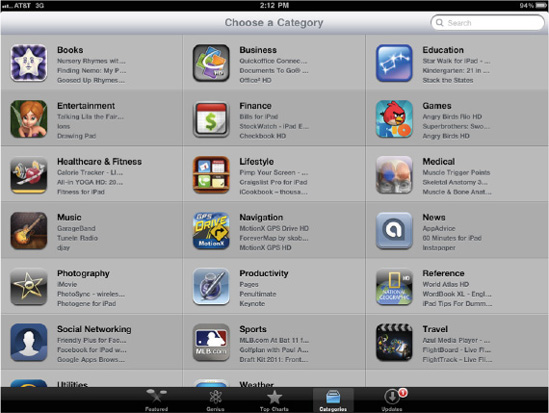
Figure 8.8. Looking for a specific type of app? The category listing groups apps with similar functionality.
By using categories, you've reduced the number of apps to look through to a manageable number. It's a great way to make the best use of your App Store shopping time.
What if browsing through the App Store just isn't leading you to the one product you're looking for? If that's the case, then it's time to do a search.
The search box is in the upper-right corner of the App Store screen. To search for a keyword, type it into the search box, and then press the Search button on the iPad's virtual keyboard. You'll notice that as you're typing your keyword, the App Store app provides a list of suggestions (see Figure 8-10).
Searching can be very useful when you know part of the name of an app but can't remember the exact spelling. For instance, one of us was trying to find a note-taking app for the iPad recently. He knew that it was called either DeskPaper or PaperDesk but couldn't remember for sure. Typing paper into the search box brought up a number of suggestions, and sure enough, PaperDesk for iPad was listed. He tapped the suggestion, which took him right to the description of the app.
One great thing about buying all your iPad apps electronically is that whenever a new version of the software is published, the App Store automatically notifies you. The Updates button is the rightmost button at the bottom of the App Store screen and is probably one of the most important for keeping your apps up-to-date.
If some of the apps on your iPad have been updated, you'll be notified through the App Store icon. A small red notification circle appears on the icon displaying the number of apps that have updates waiting to be installed (see Figure 8-11).

Figure 8.11. When you have an app update available for download and installation, a red notification circle will appear on the App Store icon on your iPad.
That same number appears on the Updates button in the App Store. To install the updates, open the App Store, and tap Updates. A listing of all the available updates occupies the screen, and there's an Update All button in the upper-right corner of the screen (see Figure 8-12). Tap that button to begin the download and installation of the app updates.

Figure 8.12. When there are app updates available, tapping the Update All button downloads and installs all of them.
You'll be prompted to enter your iTunes password in order to validate your request. Once that's been done, the application updates download and install. If the application update is more than 20MB in size and you're using an iPad with Wi-Fi + 3G, then a warning appears noting that you must be connected to the much faster Wi-Fi network before downloading the update. Any smaller updates are downloaded and installed immediately, even over the 3G network.
At the time of publication, app updates are free. However, there has been some discussion of allowing developers to charge for major version updates of their apps to provide for funding of continued development.
The App Store is the place to shop if you're looking for games or other software, but what if you want to buy music, movies, or TV shows? That's the purpose of the iTunes app on your iPad (see Figure 8-13).
The first thing you may notice is the similarity in the design of the iTunes Store and that of the App Store. The iTunes Store came first and was refined over many years, so Apple took the same concept and applied it to the App Store and the new iBookstore. The iTunes store has one nice feature the App Store doesn't: previews. To preview any song, video, or movie in the store, tap it. Song previews run for 90 seconds, while video, movie, and TV show previews vary in length.
Both stores have a set of buttons across the top and bottom of the screen. For the App Store, those buttons are New, What's Hot, and Release Date. In the iTunes Store, the buttons are replaced with Featured, Top Charts, and Genius.
Along the bottom of the screen are buttons for all the different types of media that you can download from iTunes. The media types consist of Music (single tracks or albums by musical artists), Movies, TV Shows (single episodes or full seasons), Podcasts, Audiobooks, and iTunes U. There's also a button for entering Ping, Apple's media-oriented social network.
The top and bottom buttons work in tandem to show you what's hot in all the different media. I'll explain how they work similarly for music, movies, and TV shows.
Tapping the Featured button at the top of the iTunes Store when Music is selected at the bottom of the screen displays the now-familiar New and Noteworthy list. This time, of course, we're not talking about apps; instead, we're talking about music. Both singles and full albums can be found in New and Noteworthy.
Further down the screen will be buttons linking to special singles and albums, music videos, and items available for pre-order, followed by a section containing content that varies. For example, this section featured "Metal Albums for $7.99" when we were writing this paragraph. The section changes depending on what the iTunes Store staff decides to sell at any point in time, so expect this section title to change often.
At the bottom of the Featured screen is the familiar Quick Links section described in the App Store part of this chapter. The links are different and change frequently. Here's where Apple puts in links for items that are free on iTunes and gives you the ability to complete an album or buy specially priced albums and songs. Finally, the Account, Redeem, and Support buttons once again reside at the bottom of the page, providing much the same functionality that they do in the App Store.
Now, when you tap the Movies button, things change a bit. For example, New and Noteworthy changes to New to Rent or Own. We'll elaborate on movie rentals shortly, but for the time being, it's sufficient to understand that you can either buy or rent movies from the iTunes Store.
Below that is a changing section, similar to that found in the Music section of the store. It's often topical; this chapter was written about the time actress Elizabeth Taylor died, so there was a button leading to 20 of her movies in the iTunes Store. The Quick Links and various buttons take their usual place at the bottom of the page, although once again they are different from what you see in other parts of the store and change frequently.
By now, you'd expect the TV Shows button to display something similar to what you saw for Music and Movies, and you'd be correct. New and Noteworthy listings appear near the top of the pages, along with the traditional Quick Links and buttons near the bottom of the page. The same is also true for Podcasts, Audiobooks, and iTunes U.
If you're not familiar with iTunes U, it's an innovative section of the iTunes Store that provides educational podcasts and videos from universities around the globe. Yes, you can learn linear algebra, explore concepts in sedimentology and stratigraphy, or follow the history of Rome from Augustus to Constantine, and you can do it all from the comfort of your own home and your iPad.
The Ping button is a gateway to Apple's social network for music. Ping lets you follow artists and friends and displays real-time updates from those people. Through Ping, inform your followers about music you like or reviewed, and comment on their updates. To use Ping, create a free profile with your Apple ID in the Mac or Windows iTunes application by clicking the Learn More button that is visible in the upper right corner. Once Ping is activated for your iTunes account, your friend and artist feeds are visible by tapping the Ping button in the iTunes app on your iPad.
At the top of the iTunes screen on the left side, you'll see a button that changes from Genres to Categories, depending on whether you're viewing music, TV shows, movies (Genres), or podcasts or audiobooks (Categories).
In either case, tapping this button displays a list of types of media. For example, podcast categories include arts, business, comedy, and education, to name a few. Music genres include alternative, blues, children's music, and more. Like categories in the App Store, genres and categories in the iTunes store make it much easier to find what you're looking for.
At any time, you can choose to rent a movie from the iTunes Store and view it on your iPad. Rentals differ from purchases in that they have a limited lifetime on your device. When you tap the Rent button, the clock starts. You have 30 days to start watching the movie, so you can preload your iPad with movies before going on a trip. Once you have started watching the movie, you have 24 hours in which to complete your viewing. Want to watch the Star Trek movie ten times during that 24-hour period? No problem.
Once that 24-hour period of obsessive rewatching of the rental is complete or you've reached the end of 30 days without watching the movie, the movie disappears from your library. You can watch the movies you've rented from your iPad only on your iPad, so they can't be transferred to another computer or iPhone. Movies that are purchased on your computer can be transferred to your iPad or iPhone.
If you have one of the optional video-out cables that I discussed in Chapter 1, you can pipe the video that's playing on your iPad into a TV with an HDMI, component, or composite video input. The Apple Digital AV Adapter, Apple Component AV Cable, and Apple Composite AV Cable ($39 each) are perfect for watching video from the little screen (iPad) on the big screen.
When you rent a movie directly from your iPad, consider your network speed. Wi-Fi connections are generally much faster than 3G, so you'll be able to start watching the film sooner when it's downloaded over Wi-Fi.
For ongoing TV series, Apple has created the concept of Season Passes. These allow you to download every episode of a TV season. Current episodes that have previously aired are downloaded to your iPad immediately, while future episodes download after their initial TV airdate the next time you sign into iTunes.
Season Passes are a boon to series fans who don't want to miss an episode of their favorite show, and they make it easy to keep a copy of the show for posterity. As with movies, TV series can be purchased in either high or standard definition.
Many movie titles offer the choice of high definition (HD; see Figure 8-14) or standard-definition downloads. If you're an HDTV fan, you might be disappointed to find that you can't watch your videos in true HD on your iPad. What do we mean by that? The 1024×768–pixel iPad display doesn't match the aspect ratio—the ratio of width to height of a display—of either the common 1080i (1920 pixels wide by 1080 pixels high) or 720p (1280 pixels wide by 720 high) HDTV formats. The iPad display also lacks the exact aspect ratios found in many movies, commonly 16:9 or 2.35:1.
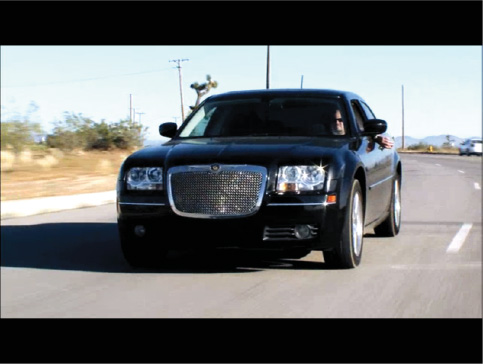
Figure 8.14. High-definition video on the iPad lets you see incredible detail even in action scenes. This image shows letterboxing (the black stripes at the top and bottom of the screen).
That's not to say that you can't display these high-definition video or movies on the iPad—you can, but they'll be letterboxed. That means black bars surround the top and bottom of the video screen, as shown in Figure 8-14. The 720p HD–formatted movies are also downscaled to the width of the iPad screen. On the plus side, video and movies look wonderful on the iPad's display regardless of letterboxing. Part of this is because of Apple's adherence to the H.264 compression scheme, which is able to compress digital video to relatively small sizes without compromising quality.
Standard-definition movies from iTunes are in a format called 720xN Anamorphic. Files are upscaled to fit the width of the iPad screen, resulting in movies that aren't as sharp as those that are HD formatted.
Another major difference between HD and standard-definition iPad movies is the size of the movie file. As an example, The Tourist is 1.37GB in size in standard definition and 3.25GB in HD (see Figure 8-15). Owners of 16GB iPads might want to stick to standard-definition movies or download only a few movies at a time.

Figure 8.15. This detailed description of The Tourist displays the Buy and Rent buttons, as well as the buttons for selecting HD or standard definition. The description displays the size of the file as well, which is important if your iPad is low on storage.
The rental and purchase prices for movies increase as you go from standard to high definition. An HD movie purchase often costs about $5 more than its SD counterpart, while rentals are usually about $1 more for HD.
Looking at Top Charts while browsing music in iTunes displays two lists: Top Songs and Top Albums. Moving downward on the Top Charts page displays Top Music Videos for your purchasing pleasure.
For movies, Top Charts displays two columns: Top Movie Rentals and Top Movie Sales. In the TV Shows category, Top Charts shows a list of Top TV Episodes and Top TV Seasons. For podcasts, the iTunes Store splits Top Charts into Top Audio Podcasts and Top Video Podcasts.
In the audiobooks category, there's simply a listing of the top 12 audiobooks, and in iTunes U, the Top iTunes U Collections shows you what is popular in the academic world.
When you're looking at music, movies, or TV shows, there's another button at the top of the page: Genius (see Figure 8-16).
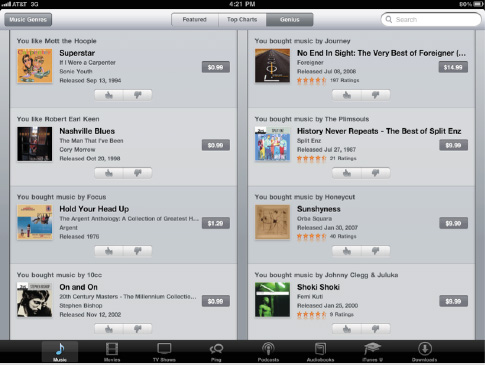
Figure 8.16. The iTunes Genius is like having your own personal shopper to recommend music or movies. Of course, you'll have to start by telling your personal shopper what you like.
Have you ever wanted to have your own consultant who could check out what music you like or the movies and TV shows you watch and then suggest new albums to listen to or videos to watch? That's exactly what the iTunes Genius function does for you.
Based on media that you have purchased through iTunes or have moved from your computer to your iPad, the Genius recommends different albums, TV shows, or movies that you may like. You can improve the accuracy of Genius recommendations by occasionally looking at them and voting with a "thumbs up" or "thumbs down."
Accuracy of Genius picks improves with frequency of purchases and rentals. Based on one movie purchase and one rental, the movie Genius did a remarkable job of picking out comedies that we might be interested in, but it also threw in some movies we'd never watch. In the TV area, we had purchased the entire first season of Star Trek: The Original Series. The Genius then thought that we would like Star Trek: Deep Space Nine, which we loathed. Once again, voting for or against recommended movies is a great idea for improving how well your Genius picks match your true preferences.
What? You haven't spent enough money yet? You can take care of that quickly with the new addition to Apple's digital stores, the iBookstore. The iBookstore was available on the iPad first, and now is available on the iPhone and iPod touch as well.
There's a reason why Apple chose to debut the iBookstore on the iPad. The iPad's book-sized backlit LED screen makes it perfect for reading books in just about any lighting condition. The battery life on the iPad is wonderful, so unless you're planning on doing a marathon reading of War and Peace, there should be no need to plug in your device while you're reading.
To take advantage of the iBookstore, you'll need to install the free Apple iBooks app onto your iPad. Probably the easiest way to do that is to tap the App Store icon and then type iBooks into the search box. The app should appear at the top of the list of suggestions, and tapping iBooks will display a handful of apps. Look for the free iBooks app, install it by tapping the Free button, and then tap the Install App button. Your iPad downloads the application and installs it.
Note
Case doesn't matter when searching in the stores. You can type a search word or phrase in lowercase, uppercase, or mixed-case letters, and you'll get the same results.
Once you've installed the iBooks app on your iPad, launch it. Unlike the App Store and the iTunes Store, iBooks doesn't start in the iBookstore. Instead, you'll see your book library, a beautiful wooden bookshelf with book covers artfully displayed (see Figure 8-17). At one point, Apple included a copy of the illustrated Winnie-the-Pooh by A. A. Milne with the iBooks app, so there may be one book on your bookshelf when you start up the app. We'll talk more about iBooks in the next chapter; here we're just concerned with the iBookstore and how to buy books.
Note
EASTER EGG ALERT! An Easter egg is a little treasure hidden in a computer program. To see an example of an Easter egg in iBooks, use your finger to drag down the bookshelves. You should find something very familiar hidden above the top row of books.
In the upper-left corner of the bookshelf is a Store button. That button is your gateway to the iBookstore. Tapping it loads the iBookstore (see Figure 8-18), which looks surprisingly similar to the App and iTunes Stores. It works the same, too; tap the price to see a Buy Book button, and then tap that button to sign into iTunes, pay for the book, and download it.
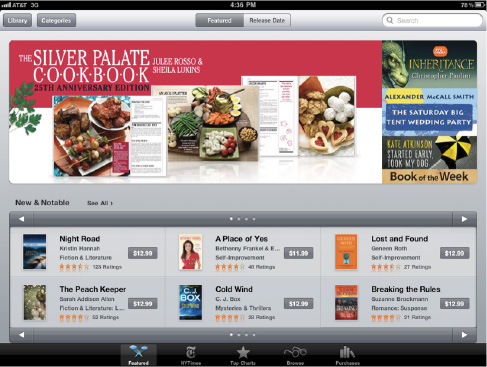
Figure 8.18. Inside the iBookstore. It's very similar to the App and iTunes Stores in both looks and operation.
Apple made the iBookstore similar to a bricks-and-mortar bookstore in that you can browse books. If you're not sure about a book, check for the Get Sample button that downloads a sizable chunk of the text for you to read. It's like leafing through a book at the bookstore.
To return to your bookshelf, tap the Library button. The Categories button provides a way to narrow down your search to a certain type of book. You know how real bookstores have signs pointing out Mysteries and Thrillers in one area and Cookbooks in another? The iBookstore categories provide the same function as those signs (see Figure 8-19).
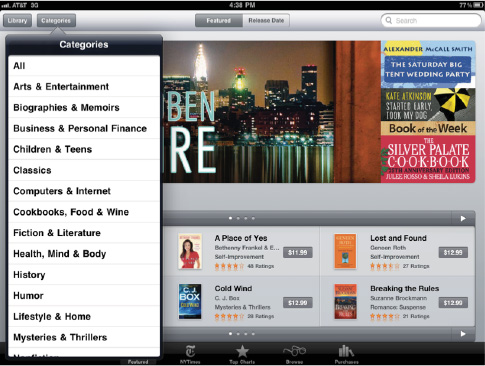
Figure 8.19. Categories are like the departments found in real bookstores. They contain books that are similar by type of content.
In keeping with the general layout of the iTunes and App Stores, buttons across the bottom of the iBookstore include Featured, NYTimes, Top Charts, and Purchases. The top of the iBookstore has buttons to provide instant listings of only featured books or all books listed by release date. When we were writing this book, the iBookstore contained over 200,000 books.
As you'd expect, the Featured button displays lists of New &Noteworthy titles and icons that lead to collections of books about a specific topic or books that the iBookstore team deems must-reads, and then another list of books that changes regularly. As we were writing this, for instance, the list was "Bestselling Bios Under $10," and it featured two books that we ended up buying.
Near the bottom of the iBookstore Featured page, you'll find the familiar Quick Links box, which in this case features not only a link to your account information but also links to book specials (see Figure 8-20). If you're a fan of Oprah's Book Club, one tap of the special link in the Quick Links box displays a list of most of the books that have been recommended by Oprah Winfrey. Build Your Library displays a collection of new best-sellers and classics that make a good addition to any library, while Free Books generates a list of classic public-domain titles from authors such as Jane Austen, Henry James, Oscar Wilde, Charles Dickens, and William Shakespeare. They're free downloads and make wonderful additions to any library. There's frequently a link for preordering books that are about to be published and have already received praise, and also a way to be alerted when your favorite author is about to publish a new book.

Figure 8.20. Fans of Oprah's Book Club will be happy to know that there's a Quick Link available to view all the books that have been chosen for the club over the years.
At the very bottom of the page you'll find the familiar Account, Redeem, and Support buttons, which perform the same functions that they do in the App and iTunes Stores.
The New York Times Best Sellers list is considered to be the list of best-selling books in the United States. Published weekly in the New York Times Book Review magazine, the best-seller list has been published continuously since 1942.
It's fitting that Apple chose to pick the authority on published books to provide an automatically updated list of fiction and nonfiction best-sellers for the iBookstore. Tapping the NYTimes button at the bottom of the iBookstore brings up the lists, which show the top ten books in each category (see Figure 8-21). To see more of the Fiction and Nonfiction Best Seller lists, there's a Show More button at the bottom of the page that will add another ten books to the list each time it is tapped.
The Top Charts button provides a function that is very similar to the same button in the App Store. In other words, it displays lists of the top paid and free books. The Top Paid Books list is often different from the New York Times Best Sellers list, because it is compiled from the sales of books available in the iBookstore.
The Top Free Books aren't likely to change very often, although renewed interest in a classic book may move a certain title up or down the list.
The Purchases screen displays any book that you have bought in the iBookstore. As you'll find out in Chapter 9, you may eventually want to delete some of the books in your personal iBooks library. If you ever want to read those books again, or at least add them back to the library for future reference, Purchases shows a Download button next to the title (see Figure 8-22) that you can use to reload a previously purchased book.

Figure 8.22. If you've deleted a book from your library and want to add it back, you can do that from the Purchases screen in the iBookstore. Tapping Download reinstalls the book to its rightful place on your bookshelf.
When you tap the Download button, the iBookstore prompts you for your iTunes password in order to validate your request. Upon entering the password and tapping OK, the book downloads and appears in your iBooks library with a "New" banner on it.
The iPad makes keeping up with your favorite TV shows, finding new music and applications, and watching your favorite movies as easy as tapping a button. Through the App Store, you have access to a large and expanding selection of software written to take advantage of the features of the iPad. The iTunes Store brings a wide variety of audio and visual entertainment to your iPad, while the iBookstore is sure to give traditional paper books a run for their money.
The following are the key points of this chapter:
The App Store, iTunes Store, and iBookstore all require an iTunes account for billing and validation purposes. Although you can set up the account on your iPad, it's usually much easier to accomplish this feat on your home computer.
All the stores require an Internet connection over Wi-Fi or 3G.
The free apps that are portals to the digital App and iTunes Stores come preloaded on every iPad. The iBookstore is accessible through iBooks, which is a free download from the App Store.
Do you need a hand in picking out movies to watch, music to listen to, or TV shows to follow? The iTunes Genius provides recommendations that get better the more you use iTunes to buy or rent media.
Be sure to consider the amount of storage in your iPad when purchasing or renting videos and movies from iTunes, because HD content consumes much more space than standard definition.
Take advantage of the free previews of music and books in the iTunes Store and iBookstore as a way to "try before you buy."

